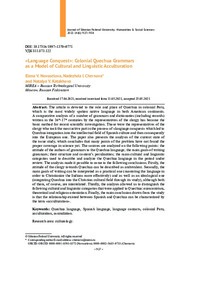Показать сокращенную информацию
«Language Conquest»: Colonial Quechua Grammars as a Model of Cultural and Linguistic Acculturation
| Автор | Novoselova, Elena V. | en |
| Автор | Chernova, Nadezhda I. | en |
| Автор | Katakhova, Natalya V. | en |
| Автор | Новосёлова, Е. В. | ru_RU |
| Автор | Чернова, Н. И. | ru_RU |
| Автор | Катахова, Н. В. | ru_RU |
| Дата внесения | 2021-06-24T08:28:17Z | |
| Дата, когда ресурс стал доступен | 2021-06-24T08:28:17Z | |
| Дата публикации | 2021-06 | |
| URI (для ссылок/цитирований) | https://elib.sfu-kras.ru/handle/2311/141358 | |
| Аннотация | The article is devoted to the role and place of Quechua in colonial Peru, which is the most widely spoken native language in both American continents. A comparative analysis of a number of grammars and dictionaries (including records) written in the 16th‑17th centuries by the representatives of the clergy has become the basic method for recent scientific investigation. Those were the representatives of the clergy who took the most active part in the process of «language conquest» which led to Quechua integration into the intellectual field of Spanish culture and then consequently into the European one. The paper also presents the analysis of the current state of the issue study, which concludes that many points of the problem have not found the proper coverage in science yet. The sources are analyzed on the following points: the attitude of the authors of grammars to the Quechua language; the main goals of writing grammars; their structure and content’s peculiarities; the main cultural and linguistic categories used to describe and analyze the Quechua language in the period under review. The analysis made it possible to come to the following conclusions. Firstly, the attitude of the clergy towards Quechua can be described as ambivalent. Secondly, the main goals of writing can be interpreted as a practical one (mastering the language in order to Christianize the Indians more effectively) and as well as an ideological one (integrating Quechua into the Christian cultural field through its study), although both of them, of course, are interrelated. Thirdly, the analysis allowed us to distinguish the following cultural and linguistic categories that were applied to Quechua: eurocentrism, theoretical and religious orientation. Finally, the main conclusion drawn from the study is that the relationship existed between Spanish and Quechua can be characterized by the term «acculturation» | en |
| Аннотация | В статье рассматривается роль и место в колониальном Перу народа кечуа – крупнейшего по числу носителей индейского языка в обеих Америках. Ведущим методом исследования стал сравнительный анализ ряда грамматик и словарей (в том числе используется и архивный материал), написанных в XVI–XVII вв. представителями клира. Именно они приняли наиболее активное участие в процессе «языковой конкисты», то есть интеграции кечуа в интеллектуальное поле испанской и, как следствие, европейской культуры. Представлен также анализ современного состояния изученности вопроса, в котором делается вывод, что многие аспекты проблемы еще не нашли должного освещения в науке. Источники проанализированы по следующим аспектам: отношение авторов грамматик к языку кечуа; основные цели написания грамматик; характерные особенности структуры и содержания этих произведений; базовые культурно-языковые категории, с помощью которых описывался и анализировался язык кечуа в рассматриваемый период. В результате проведенного исследования сделаны следующие выводы. Во-первых, отношение клира к кечуа можно охарактеризовать как амбивалентное. Во-вторых, основные цели написания: практическая (овладение языком с целью более эффективной христианизации индейцев) и идеологическая (включение кечуа в орбиту христианского культурного поля посредством его изучения), хотя обе они, конечно, взаимосвязаны. В‑третьих, можно дифференцировать следующие культурно-языковые категории, которые применялись по отношению к кечуа: европоцентризм, теоретичность и религиозная направленность. Наконец, главный вывод, который был сделан по результатам проведенного исследования, заключается в том, что существовавшее взаимодействие между испанским языком и кечуа можно охарактеризовать термином «аккультурация» | ru_RU |
| Язык | en | en |
| Издатель | Сибирский федеральный университет. Siberian Federal University | en |
| Тема | Quechua language | en |
| Тема | Spanish language | en |
| Тема | language contacts | en |
| Тема | colonial Peru | en |
| Тема | acculturation | en |
| Тема | assimilation | en |
| Тема | язык кечуа | ru_RU |
| Тема | испанский язык | ru_RU |
| Тема | языковые контакты | ru_RU |
| Тема | колониальное Перу | ru_RU |
| Тема | аккультурация | ru_RU |
| Тема | ассимиляция | ru_RU |
| Название | «Language Conquest»: Colonial Quechua Grammars as a Model of Cultural and Linguistic Acculturation | en |
| Альтернативное название | «Языковая конкиста»: колониальные грамматики кечуа как модель культурно-языковой аккультурации | ru_RU |
| Тип | Journal Article | en |
| Контакты автора | Novoselova, Elena V.: MIREA – Russian Technological University Moscow, Russian Federation; ORCID: 0000–0001–8593–8572 | en |
| Контакты автора | Chernova, Nadezhda I.; MIREA – Russian Technological University Moscow, Russian Federation; chernova@mirea.ru; ORCID: 0000–0002–5685–9733 | en |
| Контакты автора | Katakhova, Natalya V.: MIREA – Russian Technological University Moscow, Russian Federation | en |
| Контакты автора | Новосёлова, Е. В.: МИРЭА – Российский технологический университет Российская Федерация, Москва | ru_RU |
| Контакты автора | Чернова, Н. И.: МИРЭА – Российский технологический университет Российская Федерация, Москва | ru_RU |
| Контакты автора | Катахова, Н. В.: МИРЭА – Российский технологический университет Российская Федерация, Москва | ru_RU |
| Страницы | 927–938 | ru_RU |
| DOI | 10.17516/1997–1370–0771 | |
| Журнал | Журнал Сибирского федерального университета. Гуманитарные науки. Journal of Siberian Federal University. Humanities & Social Sciences; 2021 14 (6) | en |

